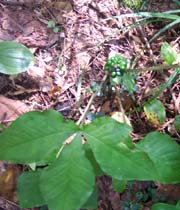
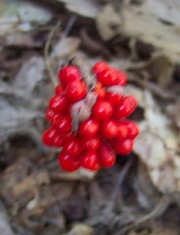
Jack-in-the-Pulpit (Arisaema) Berries: Nestled at the base of
two stout stems each supporting three broadly lanceolet
leaves. The berries will eventually turn fiery red.
Location: Ramsey's Draft Wilderness, GWNF, VA. Ripe berries
(The leaves hve died back.). Location: BFT, PA.
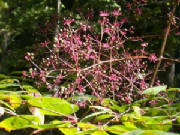
Berries of Devil's Walking Stick, AKA Hercule's Club (Aralia
spinosa): A tall shrub/short tree which has dangerous
thorns at limb junctions and the rest of the bark, hence the
name. Fruit in fall. Location: Prince Williams National
Forest Park, VA. Photo by Ken Clark.
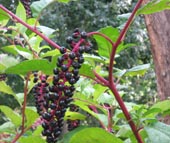
Pokeweed
Berries (Phytolacca americana): Commonly called
Inkberry.
The early
colonists used the juice of the berries as a dye. The seeds in
the berries are poisonous to mammals. Birds cannot digest
them. Photo by Dave Bennick.
|
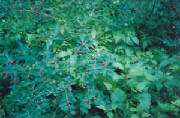
Spicebush (Lindera benzoin) berries: Small yellow
flowers atop dense understory in the spring. Location: All
around SNP, VA.
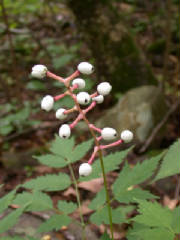
White
Baneberry/Doll's eyes (Actaea
pachypoda
): Clusters of fine, white flowers give rise to these in
late spring/early summer. Location: SNP, VA. Photo by Ken
Clark.
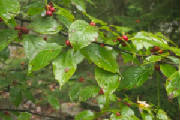
Berries of Shadbush, Service Berry (Amelanchier arborea):
A small tree and one of the first to bloom in our region.
Location" Bear Pen Tr, Tea Creek Backcountry, MNF, WV.
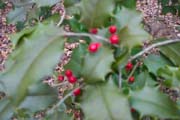
American Holly (Ilex opaca): Evergreen Holly. Male
and Female individuals. Males bear fruit in the winter, Can
grow to 40 feet. Location: Prince Williams National Forest
Park, VA. |
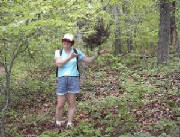
Witch's Broom: Actually a disease caused by parasitic aphids
that attacks shrubs and trees causing the affected part to
grow in a dense clump.
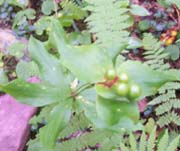
Green berries of the Indian Cucumber Root (Medeola
virginiana). Drooping, yellow flowers give rise to
these green berries which eventually turn blue. Note the six
lanceolete leaves on the same plane below the set of 3
leaves and berries. The tubers are edible raw and taste like
... cucumber.
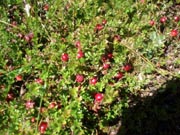
Cranberries (Vaccinium
macrocarpon) - Very tart fruit. Loves acidic soil. Location:
Dunkenbarger Run, Dolly Sods Wilderness, WV.
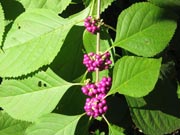
American
Beautyberry (Callicarpa americana ): Can reach nine
feet in height. A jelly can be made from the berries. Photo
by David Bennick. |
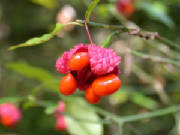
Hearts-a-Bursting/Strawberry Bush (Euonymus
americana ):
Tall, evergreen shrub.
Yellow flowers give rise to strawberry-like fruit which
burst open in the fall to reveal 4 smaller fruit. Location:
Prince Williams National Forest Park, VA. Photo by Ken
Clark.
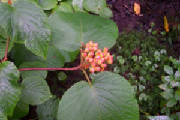
Hobblebush Viburnum, Witch's Hobble (Viburnum
lantanoides): White flowers give rise to these berries
which eventually turn red. An understory bush that sets new
roots when branch ends touch the ground. Location: West Fork
of Tea Creek Tr, MNF, WV.
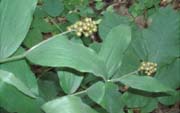
False
Solomon's Seal berries (Smilacina racemosa): In the
lily family. Stalk of delicate white flowers give rise to
these green berries which will become speckled with red
before turning translucent ruby red. Location: Wild Oak
National Recreation Tr.
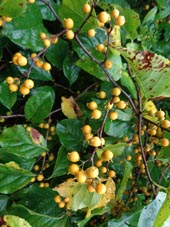
American
Bittersweet (Celastrus
scandens): Tiny green flowers give
rise to brilliant yellow pea-sized berries. These open to
reveal red fruit/seeds). |
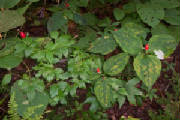
Toadshade (Trillium sessile) berries: Grows
in shaddy forests. Location: Gaule Mt. Trail, MNF, WV.
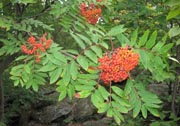
Mountain Ash (Sorbus americana) berries: Clusters
of small white flowers give rise to these in
September/October.
Photo by David Bennick.
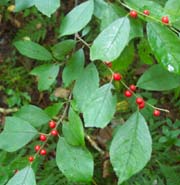
Winterberry Holly (Ilex
verticillata): A deciduous Holly. Location: Little North
Mt, GWNF, VA.
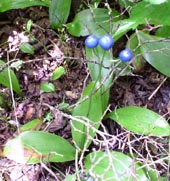
Berries of
Yellow Clintonia or Corn Lily
(Clintonia borealis):
Photo by Dimitri Tundra. |

